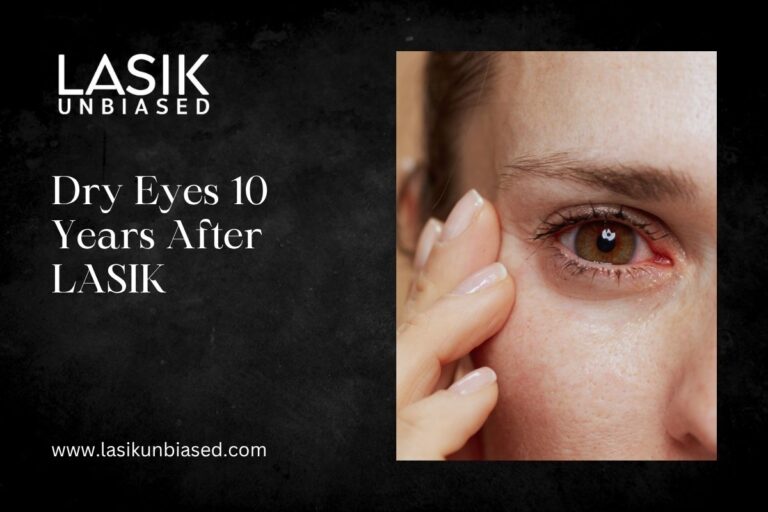Yes, dry eyes can persist or even develop 10 years after LASIK, though it’s less common than in the months immediately following surgery.
Some people experience lingering or delayed dry eye symptoms that affect comfort and quality of life, even a decade after their procedure.
If you’re noticing dryness, irritation, or fluctuating vision years after LASIK, you’re not alone—and there are ways to manage and improve your symptoms. This blog explains why dry eyes can occur so long after surgery, how to recognise the signs, and what you can do to find relief.
Why Do Dry Eyes Occur So Long After LASIK?
Nerve Regeneration Issues
During LASIK, creating the corneal flap severs some of the nerves responsible for tear production. While most people’s nerves regenerate within 6–12 months, for some, nerve function never fully recovers. This can result in long-term or late-onset dry eye symptoms.
Ageing and Tear Production
As you age, your eyes naturally produce fewer tears and the quality of your tear film may decline. Meibomian gland function (which helps prevent tear evaporation) also decreases with age, making dryness more likely, especially for those who’ve had LASIK.
Environmental and Lifestyle Factors
- Dry climates
- Prolonged screen time
- Insufficient blinking
- Contact lens use after LASIK
All of these can worsen dry eye symptoms over time, even if you didn’t notice issues right after your surgery.
Underlying Medical Conditions
Autoimmune diseases (like Sjögren’s syndrome), diabetes, or medications such as antihistamines and antidepressants can reduce tear production and contribute to chronic dry eye.
Tear Film Instability
LASIK changes the corneal surface, which can sometimes lead to an unstable tear film. This instability may not show up until years after surgery, especially if other risk factors are present.
Signs of Dry Eye a Decade After LASIK
Dry eye symptoms can vary in intensity from mild to severe and may include:
- Persistent dryness or gritty sensation
- Redness, irritation, or burning
- Sensitivity to light
- Blurred or fluctuating vision
- Watery eyes (paradoxically, as a response to dryness)
- Foreign body sensation
- Difficulty wearing contact lenses
- Eye fatigue, especially after screen use
If you notice these symptoms, consult an eye care specialist for a thorough evaluation.
Who Is at Higher Risk for Long-Term Dry Eye After LASIK?
You may be more likely to develop chronic dry eye after LASIK if you:
- Had pre-existing dry eye before surgery
- Are over age 50
- Are female or of Asian descent
- Have diabetes or autoimmune conditions
- Had high myopia or a high degree of correction
- Live in a dry climate or spend long hours on screens
What Are the Best Ways to Manage and Treat Dry Eyes a Decade After LASIK?
Artificial Tears
Preservative-free artificial tears are the first line of defence. Use them regularly throughout the day to replenish moisture and reduce irritation.
Punctal Plugs
Tiny, reversible plugs can be placed in your tear ducts to help retain natural tears on the eye’s surface. This is especially helpful for people who don’t get enough relief from drops alone.
Prescription Eye Drops
Medications like cyclosporine (Restasis) or lifitegrast (Xiidra) can reduce inflammation and boost tear production in chronic cases.
Meibomian Gland Therapy
If blocked oil glands are contributing to your dry eye, treatments like warm compresses, lid massage, or in-office therapies (such as LipiFlow or IPL) can help restore a healthy tear film.
Omega-3 Supplements
Adding omega-3 fatty acids to your diet (through fish, flaxseed, or supplements) may improve tear quality and reduce inflammation.
Environmental Adjustments
- Use a humidifier at home or work.
- Follow the 20-20-20 rule by taking frequent breaks from screens: every 20 minutes, focus on an object 20 feet away for 20 seconds.
- Wear sunglasses outside to shield your eyes from wind and UV rays.
- Stay hydrated and avoid smoke or strong winds.
Advanced Therapies
In severe cases, your doctor may recommend autologous serum eye drops, scleral lenses, or oral medications to support tear production and comfort.
Can Chronic Dry Eye Affect Your Vision After LASIK?
Yes, persistent dry eye can cause fluctuating or blurred vision, especially when reading, driving, or using screens. In some cases, chronic dryness can also increase the risk of regression (loss of some of the vision correction achieved with LASIK).
Intensive dry eye management can improve both comfort and visual outcomes, and may reduce the need for enhancement surgery if vision changes are linked to dryness.
Is It Possible to Prevent Dry Eyes Years After LASIK?
While you can’t always prevent dry eye, you can lower your risk and manage symptoms by:
- Treating any pre-existing dry eye before LASIK
- Following your surgeon’s aftercare instructions
- Using artificial tears and humidifiers as needed
- Scheduling regular eye exams to catch changes early
When to See a Doctor?
Get in touch with your eye care provider if you experience any of the following:
- Persistent dryness, burning, or irritation
- Sudden changes in vision
- Pain, redness, or discharge
- Difficulty with daily activities due to eye discomfort
Prompt evaluation and treatment can prevent complications and help you maintain the best possible vision.
Long-Term Comfort After LASIK
Dry eyes 10 years after LASIK can be frustrating, but with the right care and support, most people can manage their symptoms and protect their vision.
If you’re experiencing dryness, don’t ignore it—consult your eye care provider to explore treatment options and make adjustments that work for your lifestyle. With proactive management, you can keep your eyes comfortable and your vision clear for years to come.
Frequently Asked Questions
Is it normal to have dry eyes 10 years after LASIK?
It’s uncommon, but possible. Most patients recover normal tear function within a year, but some experience delayed or persistent symptoms due to nerve issues, ageing, or other health factors.
Will my dry eyes ever go away?
Many people find relief with consistent treatment and lifestyle changes, but some may have ongoing symptoms that need long-term management.
Can I have LASIK again if I have dry eyes?
If you have persistent dry eye, a second LASIK procedure may not be recommended. Your doctor will assess your corneal health and may suggest alternatives like PRK or advanced dry eye therapy.
What’s the best way to treat dry eyes years after LASIK?
A combination of artificial tears, environmental adjustments, and targeted therapies (like punctal plugs or prescription drops) is usually most effective. Your eye doctor can help tailor a plan to your needs.


